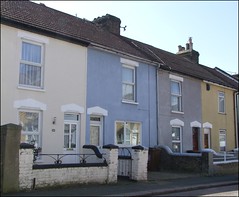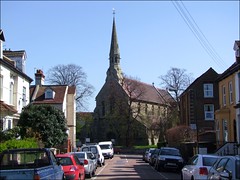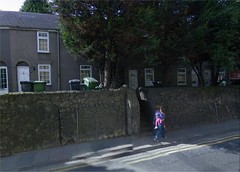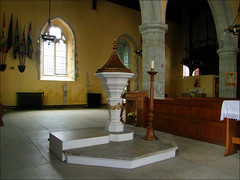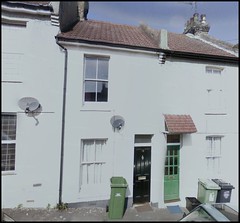MY GRANDPARENTS - I - MY GREAT-GRANDPARENTS - I - MY GREAT-GREAT-GRANDPARENTS - I - MY GREAT-GREAT-GREAT-GRANDPARENTS
KNOTT - I - BOWLES - I - WATERS - I - HARRALL - I - PAGE - I - WISEMAN - I - CROSS - I - CARTER
CORNWELL - I - HUCKLE - I - MORTLOCK - I - MANSFIELD - I - REYNOLDS - I - CARTER - I - ANABLE - I - STEARN
CHRONOLOGY - I - DRAMATIS PERSONAE - I - WHERE PEOPLE CAME FROM - I - CALENDAR
MAP OF ELY - I - MAP OF MEDWAY
MAP OF
CAMBRIDGE AND DISTRICT
WORLD WAR I - I - WORLD WAR II
simonknott.co.uk I home I e-mail
The
Bowles family: a long walk through Victorian poverty
My Father's Father's Father's Mother's family
The narrative can be read in conjunction with the Knott family tree. You can see
places significant to the Bowles family on the site map of the
Medway
This family story includes material from, and links with,
the stories of the Knott, Waters and Harrall families. My
direct ancestors are highlighted in bold
the first time they appear in the narrative.
| "I see myself, as
evening closes in, coming over the bridge at
Rochester, footsore and tired, and eating bread
that I had bought for supper. One or two little
houses, with the notice, 'Lodgings for
Travellers', hanging out, had tempted me; but I
was afraid of spending the few pence I had, and
was even more afraid of the vicious looks of the
trampers I had met or overtaken. I sought no
shelter, therefore, but the sky; and toiling into
Chatham, - which, in that night's aspect, is a
mere dream of chalk, and drawbridges, and
mastless ships in a muddy river, roofed like
Noah's arks, - crept, at last, upon a sort of
grass-grown battery overhanging a lane, where a
sentry was walking to and fro. Here I lay down,
near a cannon; and, happy in the society of the
sentry's footsteps, though he knew no more of my
being above him than the boys at Salem House had
known of my lying by the wall, slept soundly
until morning. Very stiff and sore of foot I was in the morning, and quite dazed by the beating of drums and marching of troops, which seemed to hem me in on every side when I went down towards the long narrow street. Feeling that I could go but a very little way that day, if I were to reserve any strength for getting to my journey's end, I resolved to make the sale of my jacket its principal business. Accordingly, I took the jacket off, that I might learn to do without it... My bed at night was under another haystack, where I rested comfortably, after having washed my blistered feet in a stream, and dressed them as well as I was able, with some cool leaves. When I took the road again next morning, I found that it lay through a succession of hop-grounds and orchards. It was sufficiently late in the year for the orchards to be ruddy with ripe apples; and in a few places the hop-pickers were already at work. I thought it all extremely beautiful, and made up my mind to sleep among the hops that night: imagining some cheerful companionship in the long perspectives of poles, with the graceful leaves twining round them. The trampers were worse than ever that day, and inspired me with a dread that is yet quite fresh in my mind. Some of them were most ferocious-looking ruffians, who stared at me as I went by; and stopped, perhaps, and called after me to come back and speak to them, and when I took to my heels, stoned me. I recollect one young fellow - a tinker, I suppose, from his wallet and brazier - who had a woman with him, and who faced about and stared at me thus; and then roared to me in such a tremendous voice to come back, that I halted and looked round. 'Come here, when you're called,' said the tinker, 'or I'll rip your young body open.'" - excerpts from David's journey across Kent from David Copperfield by Charles Dickens, 1850 |
North Kent looks to the Thames estuary, and to the open
sea beyond. Although its traditional industries of
brick-making, gunpowder manufacture and hop-growing are
well known, successive censuses show that a goodly
proportion of the inhabitants of parishes like Faversham,
Sittingbourne, Halstow and Upchurch earned their living
from the sea. Although the Bowles name can be traced to
Chilham, near Canterbury, we find them by the start of
the 19th Century living in Sittingbourne and Faversham,
and it is the second of these two ancient towns which
would become the family home. That the Bowles children
who came to adulthood in the late Georgian period were
mariners is beyond question, but popular family tradition
holds that their real trade was smuggling.
Uniquely in the days before the coming of the railways, seafarers were in a position to know something of the rest of England, and particularly its ports. William Bowles, though born in Faversham in 1816, was in the Devon port of Stoke Damerel in 1837, where he married a local girl, Caroline Thompson. She was my great-great-great-grandmother. They gave their address for the marriage as 76 James Street, Devonport, (the parish of Stoke Damerel included Devonport docks), and we know that Caroline's family had lived in Devonport for some years. She was born there, and her parents were married there. Soon after their marriage, Caroline gave birth to a daughter, Angelina Frances, born at 95 Pembroke Street, Devonport. However, by the time of the 1841 census, Caroline was in the Devonport workhouse with the three year old Angelina. William Bowles was not with her.
However, Caroline was soon pregnant again. And then, something extraordinary - a story handed down the Bowles family recounts how Caroline left the workhouse, and walked almost three hundred miles with her daughter Angelina to find her husband's family in Faversham, Kent. This would be an extraordinary journey even today, but in a century when a vagrant was in danger of assault in every lane and dark place, and might even be arrested for not having the correct paperwork, it was a remarkable undertaking while pregnant and accompanied by a small child. Caroline reached Faversham, and seems to have taken lodgings in the Mall at Preston-next-Faversham, on the outskirts of the town, for there it was on 1st November 1843 that her daughter Mary Ann Bowles was born, my great-great-grandmother. However, on Mary Ann's birth certificate, and in the parish records of Preston-next-Faversham, Mary Ann's father is named not as William Bowles but as Thomas Bowles, his younger brother. Thomas would be named as the father of all the children Caroline gave birth to after her arrival in Kent. The mystery remains as to whether Mary Ann was the child Caroline was pregnant with when she left Devonport. Did she lose the child, and then become pregnant again? If Mary Ann was conceived in Devon, then it seems more likely that William was the father, or possibly someone else altogether. We will never know for certain.
Altogether, we know of six children born to Caroline, four of whom were claimed as Thomas's. But there is no certain record of William Bowles's death, and there is no evidence that Caroline ever married Thomas. In 1851 she was in the Faversham workhouse with her children, while he was elsewhere. In 1854, Caroline gave birth to a child in the Faversham workhouse and was not prepared, or able, to declare the father's name. As late as 1861, Caroline was living in Faversham with Thomas and four of the children, but Thomas's relationship to Caroline is recorded on the census as 'brother-in-law'. However, Thomas died in 1870, and the 1871 census a few months later found Caroline willing to describe herself as a widow for the first time. These are her children:
| Angelina
Frances Bowles Born 95 Pembroke Street, Devonport, Devon on 2nd June 1838. The birth was registered on the 5th June 1838, by her father William, also of Pembroke Street. She was baptised at St Andrew's church, Stoke Damarel on 10th September 1838, when her father's name was recorded as William in the registers. In 1841 she appears on the census under the name Frances with her mother in the Devonport workhouse. She was with her mother in the Faversham workhouse in 1851. In 1861 she was living with her parents in Faversham. She is not apparent in 1871, but may have married or died between 1861 and 1871. Mary
Ann Bowles Susannah
Bowles Deborah
Bowles Charles
Bowles John
Bowles |
At the time of the 1861 census, Caroline's daughter Mary Ann, my great-great-grandmother, was living at Chatham, a seventeen year old servant girl in the household of her great- uncle and great-aunt Stephen and Mary Hudson. She is described as 'niece' on the census, but Mary was the sister of Thomas and William's father, Thomas Bowles senior, born at Chilham in 1791, so Mary Ann was actually their great-niece. A mile or so off from the Hudsons' house in Chatham, my great-great-grandfather George Knott, aged 18, was living with his mother in Gillingham. It is quite possible that by 1861 Mary Ann Bowles already knew George Knott, but on the 17th August 1862 she married Henry Welch at Faversham parish church. Mary Ann was pregnant, and their son Charles Henry Welch was born in early 1863. About this time, Henry Welch's father died, and the couple seem to have returned to Gillingham to look after his mother, his siblings, and the family greengrocer business.
It is unclear what happened next, but by March 1866 George Knott and Mary Ann Welch were living as man and wife at High Street, Gillingham, and Mary Ann had given birth to George Knott's son, who was called George Bowles Knott, with no mention of Mary Ann's married name on the birth certificate. But George and Mary Ann were not married. Henry Welch and their son Charles were living with Henry's recently widowed mother at New Brompton, a mile away. George and Mary Ann moved to Upchurch, just outside of the Medway Towns, where a second son was born in 1868, and then on the 3rd December 1869 at Upchurch was born their third son, my great-grandfather William Knott. The 1871 census shows George and Mary Ann living in Upchurch with their three sons, George being recorded as a labourer. And then, a few months later, Mary Ann's legal husband Henry Welch died of smallpox.
At last, George and Mary Ann were free. They married at All Saints, Frindsbury, Kent on 17th March 1872. Mary Ann gave her name as Mary Ann Welch and her status as widow. The witnesses were George's sister Jane and her husband, Joseph Cox. There would be five more children, and George and Mary Ann would call their eldest daughter Caroline after both their mothers, and their youngest son after her supposed father Thomas; but three of George and Mary Ann's children would be dead by the time of the 1911 census. Several of the Knott boys were professional soldiers. One of them spent most of twenty years in India before fighting in Iraq in the First World War, which he survived. Another brother headed off to Ireland, and we find him in 1901 in Portsmouth as an infantry instructor. He died young, as did his sister Caroline and his brother Albert. These are the eight children of George and Mary Ann Knott:
George Bowles Knott Born on the 29th March 1866 at High Street, Gillingham. George's mother gave her name as Mary Ann Knott formerly Bowles on the birth registration, with no indication that her surname was Welch. The certificate gives George's father's occupation as a brick labourer. George was still at home in Frindsbury at the age of 25 for the 1891 census, but by 1901 he had moved to Greenwich in south London where he was working as a labourer in a chemical factory. He was boarding in the household of Thomas Pattenden, a gasworks labourer. In 1911 he was a print worker living in Whalley near Clitheroe in Lancashire, boarding in the household of Thomas Harris, a gardener. He was still unmarried, and it seems likely that he never married. George stayed in Lancashire, living at Marlborough Street, Clitheroe. In early 1836 George was taken into Coplow View, the former Clitheroe workhouse which had become a public assistance hospital, and he died there of a stroke on 24th March 1936, a few days before his 70th birthday. On the death certificate, his occupation was given as general labourer. Joseph
Knott William
George Knott Frederick
Knott Frederick was in service for more than 22 years, almost entirely in India. He began his military career as a gunner, soon rising to Corporal. But in 1904, for reasons unexplained, he underwent a trial and was demoted to gunner. He fought in the North West Frontier expedition to the Punjab in the 1890s, and then spent much of the next twenty years garrisoned in India. He appears on the 1911 census at the Royal Field Artillery barracks in Barrackpore in Calcutta. In 1915 he formed part of the Eastern Mediterranean Expeditionary Force to Mesopotamia, the modern Iraq. His medal record shows that he arrived in Mesopotamia on the 29th August 1915. He was discharged as physically unfit on the 26th April 1917. He was 45 years old. He survived the First World War. At the time of the 1925 Kelly's Directory of Rochester, Chatham, Gillingham, etc, there is a Frederick Knott living at 3 Eastgate Terrace, Rochester. It may well be him. Albert
Knott Caroline
Jane Knott There is then a gap of eight years until Lilla
Marian Knott Thomas
Edward Knott |
My great-grandfather William had been born in Upchurch, but when he was about three years old he moved with his parents and brothers to the neighbouring village of Halstow for the birth of Albert and Caroline, both of whom would die in childhood. After this, there is a curious gap of eight years in the birth of children, although all the children declared by George and Mary Ann at the 1911 census are accounted for. We know that by 1881 the family were back in the Medway Towns at Gillingham, where George was working as a labourer in a brickfield. It seems likely that the Knott family were not very well off at this time, for in 1883 George's mother Caroline died in the Chatham Workhouse at the age of 84.
However, the following year the family were living a few miles west in Brompton Road in the Strood district of Rochester, where George and Mary Ann Knott would remain for the rest of their lives. George and Mary Ann's daughter Caroline died at the age of eight, and was buried in Strood cemetery on 23rd October 1884. The following day, their daughter Lilla was baptised at Strood St Nicholas. From this time onwards, Rochester would be seen by the family as their home town. At the time of the 1891 census, George and Mary Ann were living in Grange Road, actually just over the border from Strood in the Frindsbury district. George was working as a general labourer in the brickfields, probably the Manor Works to the north of Frindsbury. A short distance off in the rather more upmarket new houses of Bryants Terrace lived the Waters family, George and Mary Ann Waters with their daughters Mary Ann and Beatrice. My great-grandfather William Knott was still living at home at the age of 21 at the time of the 1891 census, but on the 3rd December 1892 he married Mary Anne Waters at St Mary's church in Strood, Rochester, which was roughly halfway between the Knott and Waters households. It was William's 22nd birthday. It is likely that the Knott and Waters families already knew each other before meeting in Strood. Twenty years earlier, the Knott and Waters families had both been living at the adjacent villages of Upchurch and Low Halstow.
William's grandmother, Caroline Bowles née Thompson, died at the age of 83 at her daughter Susannah's house in Sittingbourne in 1898. Before then, William and his new bride had moved into a house in Cuxton Road on the other side of Strood High Street, where their eldest daughter was born nine months later. William worked as a labourer in a cement factory, probably on the Frindsbury waterfront. Another daughter was born in Cuxton Road, and then the family moved right into the centre of Strood on London Road. They were there for the birth of a daughter and for the 1901 census, before moving back to Cuxton Road.
Then, in the early years of the 20th Century, William and Mary Ann took their family some fifteen miles west to Dartford, for William to work in the vast cement works there. While they were there, their youngest son was born, Vincent Helgia Knott, my grandfather. He was born on the 15th of February 1908 at 34 West Hill, Dartford in Kent. The house still exists, on the main road into the centre of Dartford from London. Vincent Helgia was baptised at Holy Trinity, Dartford on 22nd April 1908. As a very young child, he would be put on the bar of the One Bell at Wilmington in Dartford, the beerhouse then run by his mother's parents, and asked to sing. As a result, he acquired the nickname 'Joe' among the customers. He was called Joe by everyone who knew him for the rest of his life.
By the time of the 1911 census the family had moved to Providence Street in Greenhithe on the outskirts of Dartford, on the edge of the cement works where William Knott worked. This is now the site of the Bluewater shopping centre. By the end of the decade, the family were back in the Strood district of Rochester, living at 96 Temple Street, not far from George and Mary Ann's shop. William and his wife would also now remain in Rochester for the rest of their lives.
William was a labourer, like all of my great-grandfathers, but he seems to have had more physically demanding jobs than many of my other ancestors, describing himself variously as a cement labourer, a chalk digger, a burner in a cement factory, a brickfield labourer and even a stevedore. William and Mary Ann had six children:
Daisy Mary Knott Born 1893 in Strood. Daisy was baptised at St Nicholas, Strood on September 13th. The registers show that the family were living at Cuxton Road, Strood, Kent. In 1901 she was staying with her grandparents George and Mary Ann Waters in Hitchin, Hertfordshire. In 1911 she was with them at the One Bell, the pub they kept at Wilmington near Dartford. On 3rd April 1912 she was married at St Michael's church, Wilmington. She gave her address as the One Bell public house, and so did her new husband Charles James Marchant, who gave his occupation as an instructor in physical culture. Her father William and her sister Gladys were witnesses. Interestingly, Daisy gave her age as 21. In fact, she was just 18. Her grandfather had died in 1911. It seems probable that she said she was 21 to enable them to be married under licence, but is it possible that she gave a false age to enable her to take on the running of the One Bell with Charles Marchant now that her grandfather was dead and her grandmother was infirm? Daisy was probably the Daisy Mary Merchant who died at Ashford in Kent in 1962. If so, her age was given as 61, but really she was a few months short of her 70th birthday. Gladys
Violet Knott Pansy
Miriam Knott William George Knott Vincent
Helgia 'Joe' Knott Iris Alberta Knott |
Joe 's family lived at 96 Temple Street throughout his childhood. Joe's grandparents George and Mary Ann Knott were close at hand, and, while George was still working as a labourer, they opened a small sweetshop and general store in their Grange Road terraced house. The shop was in business at the time of both the 1901 and 1911 censuses. In 1913, Kelly's Directory of Kent, Surrey and Sussex listed the following under shopkeepers: 'Knott George 58, Grange Road, Frindsbury, Rochester'. It was probably the most stable and successful that either side of the family had been for generations. On 27th November 1916, Mary Ann Knott, formerly Welch, née Bowles, died of liver cancer at the Grange Road house. She was 73 years old. 58 Grange Road survives today as a private house. Her husband George George Knott died on the 11th June 1921 at his son's home, 96 Temple Street. He was 78 years old. my grandfather Joe Knott was a thirteen year old boy living in the house at the time. Both George and Mary Ann were buried in plot A192 of Strood Cemetery, just to the south of the cemetery chapel.

Joe may have worked as a labourer in a cement works after he left school, but in about 1931 he left Rochester looking for work. The family continued to live in Temple Street, but it was badly bombed during the Second World War and finally demolished in the 1960s. The photograph above was taken just before the final demolition of the street - the houses on the left hand side are already boarded up. The identity of the woman is unknown. The location is now the site of Strood Tesco. In February 2011, while wandering around this area, I met an old couple who had both been children on Temple Street at the time Joe was growing up there. They were able to point out exactly where 96 Temple Street had been (now within the Tesco car park) and they gave me a vivid picture of life in the street at that time. They had not known the Knotts by name, but it felt like a remarkable touchstone.
Joe would not go back to live in the Medway Towns. In the early 1930s he worked on road-building projects in Yorkshire where he met Arthur Page, the brother of his future wife Phyllis. Arthur was another migrant worker, and Joe came back with him to East Anglia, where he met my grandmother. Joe went to work for British Sugar at Cantley in east Norfolk, but he married Phyllis Page at Ely Register Office on 15th August 1932, when he was 24 and she was just 19. Joe's address was 9 Council Cottages Cantley. Interestingly, he gave the occupation of his father as Greengrocer, although it is unlikely that William had taken over the running of his father's shop in Grange Road, because the street directory of 1925 shows it under different occupation. The witnesses were Phyllis's brother Percy and her sister Violet.
They went to live at Council Cottages, Cantley, and then in 1933 they moved to Ipswich, firstly living in lodgings in Tacket Street in the town centre, and then in a rented house in Cavendish Street, the same street that I would live in almost exactly half a century later. Joe worked for Fisons on Cliff Road, who were constructing a new factory. They moved to 20 Fletcher Road on the new Gainsborough Estate in Ipswich, where their first child and only daughter was born. The factory was completed the following year, and they returned to Ely in 1935, where they would remain.
Joe and Phyllis lived at 25 Willow Walk off of Waterside, where my father and his three brothers were born - Joe and Phyl had five children in all. The house is now demolished. Joe Knott rarely spoke about his family in Kent, and his children were told almost nothing about them, although they did on occasion in the 1940s receive visits from his sister Gladys and his brother William. Joe was 31 when the Second World War broke out. He spent the War as a motorcycle dispatch rider, mostly in Italy. After he returned to Ely, the family moved to a new council house at 37 Chief's Street in 1947. They lived there for the rest of their lives. In the 1940s and 1950s Joe bred racing pigeons and canaries.
Joe's parents, my great-grandparents, both died in the early 1950s. William Knott died on 27th July 1951 of exhaustion and internal haemorrhage. Mary Ann Knott died on 15th April 1952 of heart failure and senile decay. They both died at 143 Maidstone Road, Rochester, the home of their daughter Gladys Violet Allen, who notified both deaths. William and Mary Ann were buried in the same grave plot as William's parents, plot A192 in Strood Cemetery.
Joe worked for British Sugar until he retired in the early 1970s. For a while, Joe and Phyllis owned a caravan in Heacham, and enjoyed holidays on the Norfolk coast. He had a great pride in his garden at Chief's Street, spending hours tending his fruit and vegetables until he was well into his eighties. I would regularly visit them at Chief's Street in the late 1970s and 1980s, and Joe was aways keen to show me around his garden. I am pleased that I have a photograph, taken in 1987, of him doing this. I particularly remember his gooseberry bushes - he would take great delight in watching his grandchildren trying to eat the sour fruit! Joe's children were near at hand, one son living a few streets away and all the others within 15 miles or so. His wife Phyllis's brother and sister also lived nearby. Joe is still remembered for his fondness for the horses, and his friendships with prominent sportsmen. He never went back to Kent. He outlived my other grandparents, lived to hold my son as a baby, and died in Ely in the Princess of Wales Hospital in 1996 at the age of 87.
AT A GLANCE: DETAILS FROM REGISTERS AND CENSUS DATA |
|
||||||||||||||||||||||||||||||||||||||||||||||||||||||||||||||||||||||||||||||||||||||||||||||||||||||||||||||||||||||||||||||||||||||||||||||||||||||||||||||||||||||||||||
